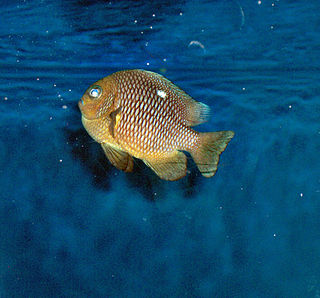
The threespot dascyllus, also known as the domino damsel or simply domino, is a species of damselfish from the family Pomacentridae. It is native to the Indo-Pacific from the Red Sea and East Africa, to the Pitcairn Islands, southern Japan, and Australia. Its grey to black body has two lateral white spots and one between the eyes like domino hence the name; the threespot dascyllus grows up to 13 cm in length. Coloration is somewhat variable; the spot on the forehead may be absent and the lateral spots very much reduced. It feeds on algae, copepods and other planktonic crustaceans.
Verduya's hap is a species of haplochromine cichlid which is endemic to Lake Malawi where it has a lake wide range and so is found in Malawi, Mozambique, and Tanzania. This species occurs in open water, sometimes forming large shoals.

The flat-faced seahorse, longnose seahorse, low-crowned seahorse or three-spot seahorse is a species of fish in the family Syngnathidae. It is found in Australia, Cocos (Keeling) Islands, French Polynesia, Hong Kong, India, Indonesia, Japan, the Philippines, Singapore, Taiwan, Thailand, and Vietnam. Its natural habitat is shallow seas. It is threatened by habitat loss.

Threespot barb is a species of cyprinid fish in the large genus Enteromius. It has a wide distribution in sub-Saharan Africa from the Congo Basin east to the Indian Ocean coast of Tanzania and south to KwaZulu Natal in South Africa. It occurs in shallow water around river inflows or near swampy areas. It is a habitat generalist and also hardy, but it prefers vegetated areas. It feeds on insects and other small animals. It is often caught for use as bait by anglers fishing for tigerfish. It breeds during the summer rainy season when shoals of fertile adults migrate upstream when the rivers are in spate following rain. A single females may produce as many as 8,000 eggs.

Pristicon trimaculatus, the 'three-spot cardinalfish, is a nocturnal fish that lives in the Western Pacific Ocean, living around inshore coral reefs in waters around the Ryukyu Islands and Western Australia and the southern Great Barrier Reef, east to Samoa and the Marshall Islands. This species is uncommon. Juveniles have intense, dark markings on a light background, while adults' markings are dusky.

Homonoeini is a tribe of longhorn beetles of the Lamiinae subfamily. It was described by Thomson in 1864.
Notomulciber is a genus of longhorn beetles of the subfamily Lamiinae, containing the following species:
Notomulciber enganensis is a species of beetle in the family Cerambycidae. It was described by Stephan von Breuning in 1939.
Notomulciber ochraceomaculatus is a species of beetle in the family Cerambycidae. It was described by Stephan von Breuning in 1939.
Notomulciber javanicus is a species of beetle in the family Cerambycidae. It was described by Stephan von Breuning in 1956.
Notomulciber travancorensis is a species of beetle in the family Cerambycidae. It was described by Stephan von Breuning in 1958.
Notomulciber sexlineatus is a species of beetle in the family Cerambycidae. It was described by Stephan von Breuning in 1959.
Notomulciber basimaculatus is a species of beetle in the family Cerambycidae. It was described by Stephan von Breuning and de Jong in 1941. It is known from Sumatra.
Notomulciber palawanicus is a species of beetle in the family Cerambycidae. It was described by Stephan von Breuning and de Jong in 1941. It is known from the Philippines.
Notomulciber albosetosus is a species of beetle in the family Cerambycidae. It was described by Heller in 1923. It is known from Borneo.
Notomulciber biguttatus is a species of beetle in the family Cerambycidae. It was described by Francis Polkinghorne Pascoe in 1867. It is known from Borneo and Malaysia.
Notomulciber ochreosignatus is a species of beetle in the family Cerambycidae. It was described by Heller in 1921. It is known from Philippines.
Notomulciber quadrisignatus is a species of beetle in the family Cerambycidae. It was described by Bernhard Schwarzer in 1925, originally under the genus Micromulciber. It is known from Taiwan.
Notomulciber carpentariae is a species of beetle in the family Cerambycidae. It was described by Blackburn in 1894. It is known from Australia.
Notomulciber notatus is a species of beetle in the family Cerambycidae. It was described by Fisher in 1936, originally under the genus Micromulciber. It is known from Java.






